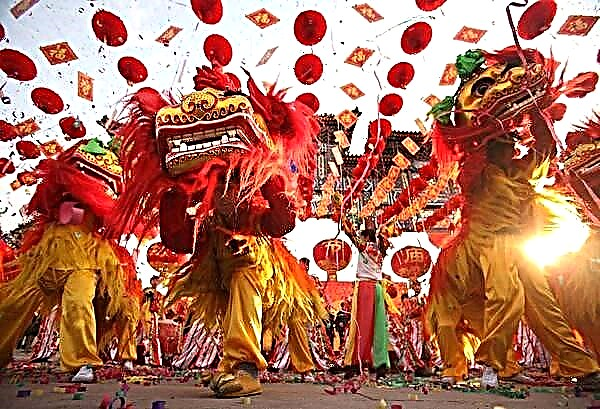The culture of China is associated with a thousand-year history. The long ban on the entry of foreigners into the country helped preserve the atmosphere, ideology and other features that were characteristic only of this state.
General characteristics of the culture of China
China's culture and traditions seem backward to the rest of the world. The main reason for this isolation is long-term isolation and the absence of the influence of other civilizations. Before 1949 year foreigners could not visit its territory, an exception was made only for trade relations.

After representatives of other countries entered the country, some traditions were banned. This approach has had a strong influence on the spiritual philosophy of the Chinese people. But since 1980 the authorities began to revive forgotten customs again, which helped the country to remain unique. Today it combines modern and old traditions in a special way, without prejudice to the spiritual values of the state.
Features of the formation of Chinese culture
Upon closer examination of the features of Chinese culture, there are several interesting facts about it:
- Uniqueness and originality. Residents continue to participate in classical rituals, do not forget about the customs.
- A complete connection between religion and nature. Any of the forces deified, is a source of inspiration for poets, artists and architects.
- Thrift and enterprise. The local people are characterized by minimalism in actions and a lack of craving for pronounced luxury.
- A characteristic feature is restraint. Chinese people never express their emotions openly.
Important! All of these features are associated with a closed way of life: it influenced the mentality, writing and spiritual values.
Philosophical and religious attitudes dominant in Chinese culture
Artistic creativity and spiritual life of the people is based on mythological, philosophical and religious concepts. Vivid manifestations include:
- Ideas about your own country. For the inhabitants, it is the center of the whole world, with an exception among the barbarian peoples surrounding the Celestial Empire.
- Extensive numerical symbology. It is clearly visible in painting, literature and architecture.
- Developed hierarchy. It begins with the son of Heaven - the emperor, who is the mediator between people and the Higher Forces. His cult can be seen in all social thoughts and political philosophy of ancient China.
Important! The main cultural dominance is imitation of nature, which is considered the main source of harmony throughout the world.

You May Also Like
The cult of the Sun is always reflected in the canvases of artists and architectural structures.
Chinese philosophy
The culture of ancient China is based on the following basic postulates:
- Ancestor cult. It is based on the recognition of the influence of the deceased ancestors on the future fate and life of their descendants. It is the responsibility of those who have left the world to take care of the living.
- The interaction of opposing principles - the system of yin (feminine) and yang (masculine). They originated in ancient times, when there was only chaos in the world. The first spirit became responsible for the earth, the second for the sky. The myths about the origin of the Universe are filled with primary natural philosophy.
- Holism. The world as a whole and each individual in it are considered from the point of view of a "single integrity", more important than the rest of the components. The unity of man and the whole world is considered harmonious, not opposing each other.
- Intuitiveness. Philosophical teaching prefers to use the methods of knowledge. The concepts of "unity" and "integrity" cannot be expressed in words or analyzed in standard terms. A person should rely only on insight with clues from intuition.
- Symbolism. The leading role is given to moral consciousness. Aesthetic sensations are combined with the will to practically fulfill the moral norms accepted in society.
- Collectivism. The public takes precedence over the personal.
- Traditionalism. The people in everything fully rely on traditions and customs.

Important! Conformism or fear of sudden changes and hierarchy are widespread in the country. The structure of society with division into higher and lower stages is recognized as inviolable.
Characteristics and values of Chinese culture
The peculiarities of culture in ancient China have also affected today's society. The following points deserve attention:
- Perception of the social environment. It is understood as an important part of one's own destiny, serves as an impartial assessment of human shortcomings and merits. The people believe that every deed is rewarded morally and is manifested through the attitude of the rest of society.
- Personal capital. Fairness and honesty in relation to other people is perceived in a pragmatic way. The regulator of behavior is the belief in objective and inevitable retribution. It is more effective than the afterlife judgment that Western religions are talking about.
Important! An optimistic outlook on life, in spite of fleeting difficulties, is predetermined by the above dogmas. The Chinese truly believe that everyone will get what they deserve in the end.
Language and writing
Among the cultural features of China, it is worth noting literary works and writing. Each of them deserves a separate consideration.
Hieroglyphs
The main means of interethnic communication in the country is the written language. It is not tied to phonetic reading and allows you to understand texts written several centuries ago.
You May Also Like
Calligraphy
For the correct drawing of symbols, it is not enough to study the hieroglyphs - you need to know the speed of drawing lines and the force of pressing the brush.

In addition to its main meaning, calligraphy is widely used as one of the means for meditation: a person should be in high spirits.
Literature
The preferences of Chinese literature have not changed today. Popular poetry includes:
- love lyrics;
- poems with religious and philosophical content;
- parables;
- description of landscapes.
Important! A less well-known section includes literature on Confucianism and poetry that glorifies the state and the ruler.
Art
Chinese culture in 15-18 century spread through painting, theater, music and dance. Chinese artisans are renowned for their work on stone, wood and bone.
Painting
Pictures are made on silk, bamboo plates. Each work of authorship has a signature.
Most of the paintings are portraits or images of nature, streets of small villages and towns, everyday life and everyday life.
Important! The drawings of mythical creatures - dragons and demons remain unchanged.
Theater and opera
Classical Chinese performing arts are presented in 2 variations:
- Southern drama with classic elements. Her performance is varied, and the vocal parts can be performed by all the acting characters.
- The northern drama includes parts borrowed from Persia and India. Leading musical roles belong only to the main characters. The piece has a clear structure.

Peking Opera originated in the 18th century. She combines vocals, music, pantomime, dance and acrobatics. It clearly shows the specificity of the ancient Chinese theater.
Dancing
The dance genre includes many traditional and advanced forms. It is used on holidays, public and state ceremonies, and various rituals.

The folk choreographic art of China has 56 directions according to the number of ethnic groups. The most famous are the lion and dragon dance.
Music
The non-standard of musical works is associated with 5 or 13 notes, and not, as is customary all over the world with 7 units. Bowed strings and string instruments are preferred by local musicians. Banhu is considered popular - its sounds resemble a classical violin.
Architecture
Architectural structures are distinguished by their harmony - they are characterized by bilateral symmetry.
Large buildings have patios. The unusual decoration of the walls and roofs attracts attention.
Stone, wood, ivory carving
Craftsmen of the country, when creating stone masterpieces, prefer:
- jadeite;
- corals;
- marble;
- soapstone;
- jade;
- transparent pink quartzite.
The skill of carving ivory figurines is equated with the beauty of stone crafts. Over the years, the country has developed separate schools dealing with its processing. The strongest of them are considered to be located in cities such as:
- Beijing;
- Guangzhou;
- Nanking;
- Tianjin;
- Shanghai.
Picture 7 Ivory carving
Wood cutting is a common area of applied craftsmanship. This subspecies developed in the 2nd millennium BC, gained particular popularity during the Ming dynasty - in the 14th century.
Houses, palaces and temples were decorated with intricate designs and whole paintings. Some of them belong to the cultural heritage of China and still exist today. There are several directions of wood carving in the country:
- by boxwood;
- gilded wooden surfaces;
- an ordinary tree.
Note! Craftsmen do not strive to carve ordinary patterns - their hands create whole pictures, regardless of size (giant panels or small samples).
The plot is chosen by the carver. Some prefer to recreate epic events, while others prefer abstract images.
Ancient China culture
The country has always amazed travelers with a number of inventions. In the old days, she was famous for her astronomers. Experts determined the dates of lunar and solar eclipses, recognized spots in the sun and warned of the appearance of comets. It was the Chinese who were the first to invent the compass, gunpowder, typography, porcelain, and paper.
The basis of writing originated in the country in the 3rd millennium BC.
Particular attention was paid to philosophy. The first famous scientist was Confucius, who laid the foundations of the doctrine of the achievement of perfection and harmony by people.
The second direction of philosophical research is Taoism with elements of religion. The path "Tao" refers to the classical theories, speaks of endless movement.
Secondary education helped prepare young Chinese for life, which included mastering:
- music;
- arithmetic;
- letters;
- etiquette;
- skills to shoot a bow and drive a chariot.
Children studied the historical annals without fail.
During the same period, the Chinese were producing silk fabrics, painting, creating unusual handicrafts from stones and wood.

The architecture was famous for its pristine nature and non-standard approach. Chinese pagodas are one of the most beautiful creations of the East.
Contemporary culture in China
There have been no global changes in the culture and religion of China. The cult of the Dragon is also revered by many citizens, and wedding ceremonies surprise many travelers. The following areas are of particular interest.
Feng Shui or a teaching that helps to live in a systematized world, balancing it. It requires the correct positioning of objects not only at home, but also in the workplace. The construction of housing in the country takes place in accordance with the rules of Feng Shui.
Important! They do not forget about safety precautions - the main problem of the state is earthquakes.
Gastronomy is a separate subdivision of the cultural heritage dating back to the Neolithic period. The dishes are strictly divided: one part of them is intended for ordinary people, the other - for dignitaries and their entourage. The originality of the cuisine is associated with the use of beetles, reptiles, cats and dogs. The main food consists of rice, soy, noodles, spices and vegetables. Duck, chicken, pork, beef and seafood are used as meat.
The film industry is experiencing an unprecedented boom (the first film was shot in 1905 year). After the proclamation of the PRC, its active growth began. In 2011, the volume of the film market took the 3rd place in the world after the USA and Great Britain.
The culture of the country is rich in its diversity and not all of its postulates are easily perceived by visitors. Despite the revolution and attempts to destroy the local color, since 1980, old traditions have begun to revive.











